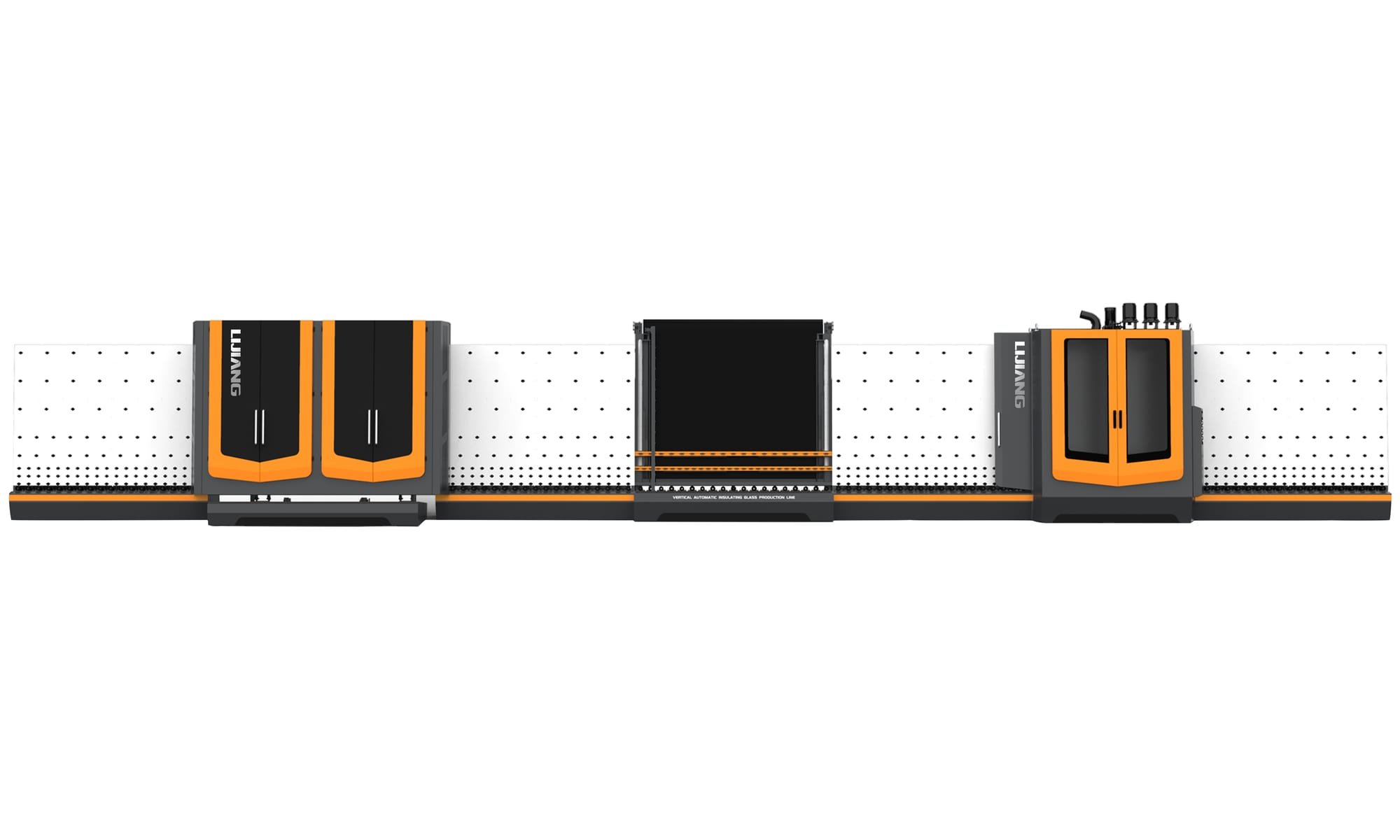Équipement de verre isolé automatique
Si vous achetez une nouvelle machine de traitement de verre isolant sur le marché actuel, vous trouverez des produits similaires partout. Que vous soyez novice ou expert, il est difficile de choisir celui qui convient le mieux à votre entreprise. Vous devrez comparer des fonctionnalités et des coûts similaires, rechercher le meilleur prix et savoir comment gérer la transaction. Voici quatre étapes faciles à suivre qu’un acheteur devrait suivre pour acheter une nouvelle machine de traitement de verre isolant.
Principe de fonctionnement de base
- Allemagne Siemens PLC système de contrôle, interface à écran tactile pour le toucher du doigt
- Identification automatique du verre à couche et du verre Low-E ;
- 3 paires de brosses douces peuvent laver le verre Low-E en ligne et le verre Low-E hors ligne ;
- Les pièces de lavage adoptent un matériau SS et un dispositif étanche;
- Réservoir d'eau avec contrôle automatique de la température et système de lavage à l'eau.
- Système de chauffage à air;
- Réglage automatique du démarrage et de l'arrêt du ventilateur d'air ;
- Système de réduction du bruit ;
- Affichage en ligne de la vitesse de lavage ;
- Travail intermittent intelligent, économie d'énergie;
- Planche de pressage réglable pour maintenir la surface de pressage de la plaque droite ;
- Mode de connexion de la prise aviation ;
- Applicable pour produire des IGU triples et des IGU en forme.
Étapes de travail détaillées
- Fonction de prélavage ;
- Positionnement automatique précis pour les DGU à 3 ou 4 marches latérales ;
- Le remplissage automatique de gaz Argon peut définir la valeur du gaz et afficher le processus de remplissage en ligne avec une concentration de gaz élevée.
Paramètre technique
| Unit | LJBZ2030 | LJBZ2030G | LJBZ2535 | LJBZ2535G | LJBZ2535DG | |
| Voltage | 380V 50Hz 3P | |||||
| Total Power | Kw | 39.5 | 36 | 41 | 39.5 | 44 |
| Washing Speed | m/min | 2-10 | ||||
| Maximum Working Speed | m/min | 45 | ||||
| Minimum Glass Size | mm | 450*280 | ||||
| Maximum Glass Size | mm | 2000*3000 2000*3500 (Secondary Tableting) | 2500*3500 2500*4000(Secondary Tableting) 2500*4500(Secondary tablet pressing and auxiliary suction cup mechanism) | |||
| Flat Glass Thickness | mm | 3~15(Could be customized 3~30) | ||||
| Washing Brushes | pieces | 6 | ||||
| Maximum Thickness of Insulating Glass | mm | 60 | ||||
| Total Gas Consumption | L/min | 1200 | ||||
| Conveyer roll Height | mm | 520 | ||||
| Dimension L*W*H | mm | 20200*3500*3200 | 23800*3500*3700 | 27200*3500*3700 | ||
Description technique

Ligne de production automatique de verre flottant isolé verticalement
Verre LIJIANG - LJBZ2030GF/LJBZ2535GF
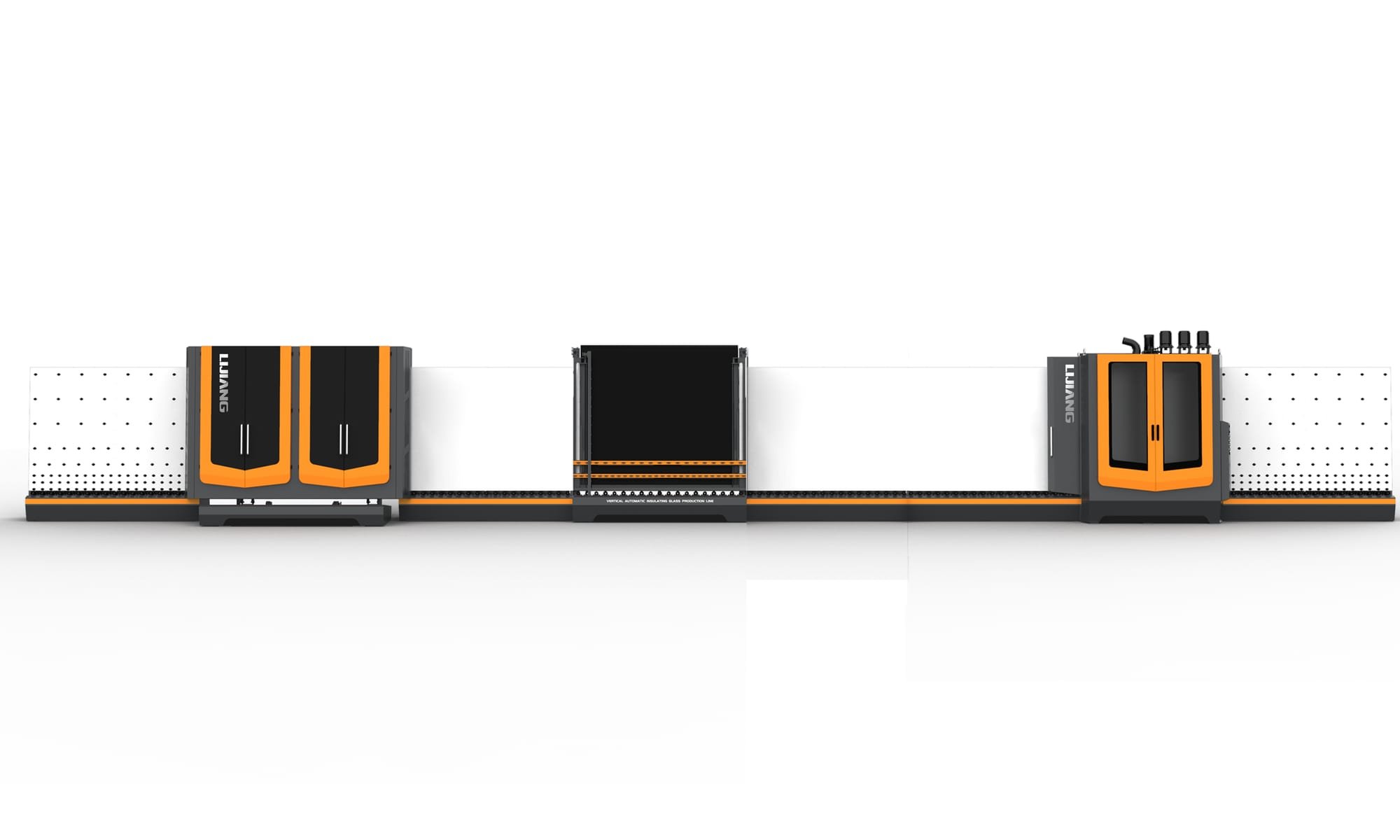
Principe de fonctionnement de base
- Air-floating back plate, to avoid the wheel scraching the glass and leaving wheel marks;
- Two pieces of IGUs or DGUs could be pressed and filled gas in once time, high work efficiency;
- Argon-gas filling in pressing, automatic filling the glass in different areas according to the size of glass;
- Germany Siemens PLC control system, touch screen interface for finger touch operating;
- Automatic identification of coated glass and Low-E glass;
- 3 pairs of soft brushes could wash online Low-E glass and offline Low-E glass;
- The washing parts adopt SS material and waterproof device;
- Water tank with automatic temperature control and water washing system;
- Air heating system;
- Air Fan automatic start and stop setting;
- Noise reduction system;
- Online display of washing speed;
- Intelligent intermittent work, saving-energy;
- Adjustable external rotary positioning system of DGUs or IGUs;
- Connection mode of aviation plug;
- ERP system is optional.
Étapes de travail détaillées
En plus des caractéristiques techniques de la ligne de production ordinaire et de la ligne de production gonflable, la ligne de production de verre isolant entièrement automatique de la série LJBZ2030GF/LJBZ2535GF ajoute une fonction de flottation à air dans la section de transmission entre la section de lavage et la section de presse à plaques, rendant le verre Surface transparente pendant le processus d'inspection. Aucun contact humain et aucune pièce d’équipement masquée. Les spécifications standard sont 2000 mm*2800 mm et 1500 mm*2200 mm.
Paramètre technique
| Unit | LJBZ2030GF | LJBZ2535GF | LJBZ2535DGF | |
| Voltage | 380V 50Hz 3P | |||
| Total Power | Kw | 41 | 44.5 | 58 |
| Washing Speed | m/min | 2~10 | ||
| Maximum Working Spped | m/min | 45 | ||
| Minimum Glass Size | mm | 450*280 | ||
| Maximum Glass Size | mm | 2000*3000 2000*3500(Secondary tableting) | 2500*3500 2500*4000(Secondary tableting) 2500*5000 (Secondary tablet pressing and auxiliary suction cup mechanism) | |
| Flat Glass Thickness | mm | 3·15(can be customized 3~30) | ||
| Washing Brushes | pieces | 6 | ||
| Maximum Thickness of insulated glass | mm | 60 | ||
| Total Gas Consumption | L/min | 1200 | ||
| Conveyer Roll Height | mm | 520 | ||
| Dimension L*W*H | mm | 20200*3500*3200 | 23800*3500*3700 | 27200*3500*3700 |
Description technique

Double plaque automatique de taille jumbo en appuyant sur la ligne de production de verre isolé de remplissage de gaz argon
Verre LIJIANG - Type : LJBZ3370
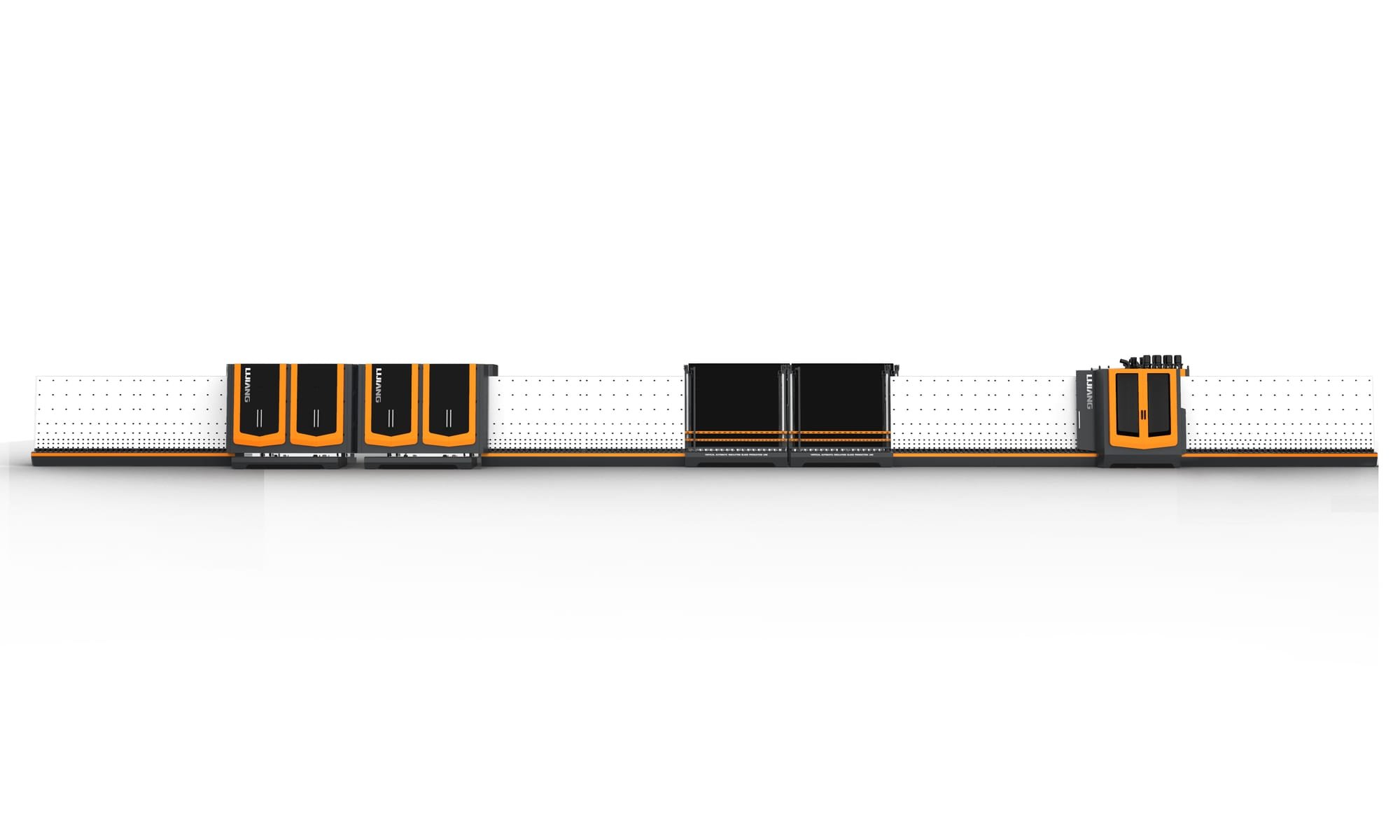
Principe de fonctionnement de base
Regular Function
Optional Function
- Germany SIemens PLC control system, touch screen interface to finger touch operating;
- Automatic identification of coated glass and Low-E glass;
- 3 pairs of soft brushes could wash online Low-E glass and offline Low-E glass;
- Water tank with automatic temperature control and water washing system;
- Air heating system;
- Air Fan automatic start and stop setting;
- Noise reduction system;
- Online display of washing speed;
- Intelligent intermittent work, saving-energy;
- Adjustable pressing board to keep the plate pressing surface straight;
- Connection mode of aviation plug
- Applicable to produce triple IGUs and shaped IGUs.
Optional Function
- Pre-washing Function;
- Automatically accurate positioning for 3 side step DGUs or 4 side step IGUs;
- Automatic argon-gas filling could set gas value and display the process of filing online with high gas concentration.
Étapes de travail détaillées
The comparison of two design structures of large-panel insulated glass production lines
For example, the maximum size of insulating glass required for a construction project is 3m*6m.
① The equipment structure:
Extended size equipment + Inside combination technology + Two plate-pressing sections + Online argon-gas filling function
Each section of the production line needs to be designed and extended to the maximum size of the large-panel insulating glass, and the equipment size of all processing sections except the vertical glass washing and drying machine is upgraded to more than 6m. At the same time, the plate pressing section is made into two sections, and the processing method of combining the plates inside the plate is adapted to meet the requirement that the maximum length reaches 6m.
Advantage:
1. It can realize the one-time plate press molding of large plate insulating glass, and complete the argon filling function at one time, without the need for multiple processing operations;
2. It can realize simultaneous pressing and inflating of two pieces of insulating glass to improve production efficiency.
Disadvantages:
1. The production line occupies a large workshop area;
2. The price is relatively high.
Know More
②The equipment structure:
Normal size equipment + Outside combination technology + Only one plate-pressing sections + Offline argon-gas filling function
It using the method of outside combination sheet + single plate press, it is necessary to combine two pieces of 3m*6m glass together outside the plate press, and the glass enters the plate press two or more times Pressing for the second time, and then manually inflating to complete the processing of insulating glass.
Advantage:
1. The equipment of the second structure is about 4 meters shorter than the double-plate press of the first structure, and the floor space is smaller.
2. The price is relatively lower than LIJIANG Glass LJBZ3370 Automatic Jumbo Size Insulating Glass Production Line.
Disadvantages:
1. The length of the plate press is not enough, it needs to be pressed twice or more times, which will cause uneven pressing of the first sealant butyl rubber coating and affect the sealing effect of the glass.
2. There is no way to fill the glass with argon gas online. The only way is to move the glass offline to punch holes and then manually inflate the gas. Manual inflation takes a long time, and it is difficult to meet the standard requirements of a gas content.
3. During the processing of large glass plates, multiple pressings are required, and the production efficiency will also be reduced.
For example, the maximum size of insulating glass required for a construction project is 3m*6m.
① The equipment structure:
Extended size equipment + Inside combination technology + Two plate-pressing sections + Online argon-gas filling function
Each section of the production line needs to be designed and extended to the maximum size of the large-panel insulating glass, and the equipment size of all processing sections except the vertical glass washing and drying machine is upgraded to more than 6m. At the same time, the plate pressing section is made into two sections, and the processing method of combining the plates inside the plate is adapted to meet the requirement that the maximum length reaches 6m.
Advantage:
1. It can realize the one-time plate press molding of large plate insulating glass, and complete the argon filling function at one time, without the need for multiple processing operations;
2. It can realize simultaneous pressing and inflating of two pieces of insulating glass to improve production efficiency.
Disadvantages:
1. The production line occupies a large workshop area;
2. The price is relatively high.
Know More
②The equipment structure:
Normal size equipment + Outside combination technology + Only one plate-pressing sections + Offline argon-gas filling function
It using the method of outside combination sheet + single plate press, it is necessary to combine two pieces of 3m*6m glass together outside the plate press, and the glass enters the plate press two or more times Pressing for the second time, and then manually inflating to complete the processing of insulating glass.
Advantage:
1. The equipment of the second structure is about 4 meters shorter than the double-plate press of the first structure, and the floor space is smaller.
2. The price is relatively lower than LIJIANG Glass LJBZ3370 Automatic Jumbo Size Insulating Glass Production Line.
Disadvantages:
1. The length of the plate press is not enough, it needs to be pressed twice or more times, which will cause uneven pressing of the first sealant butyl rubber coating and affect the sealing effect of the glass.
2. There is no way to fill the glass with argon gas online. The only way is to move the glass offline to punch holes and then manually inflate the gas. Manual inflation takes a long time, and it is difficult to meet the standard requirements of a gas content.
3. During the processing of large glass plates, multiple pressings are required, and the production efficiency will also be reduced.
Paramètre technique
| Unit | LJBZ3370 | |
| Voltage | 380V 50Hz 3P | |
| Total Power | Kw | 54.5 |
| Washing Speed | m/min | 2~10 |
| Maximum Working Speed | m/min | 45 |
| Minimum Glass Size | mm | 450*280 |
| Maximum Glass Size | mm | 3300*7000(Single-Press Mode) 3000*3000(Double-Press Mode) |
| Flat Glass Thickness | mm | 3~30 |
| Washing Brushes | pieces | 6 |
| Maximum Thickness of Insulated Glass | mm | 80 |
| Total Gas Consumption | L/min | 1500 |
| Conveyer Roll Height | mm | 520 |
| Dimensions(L*W*H) | mm | 47200*3500*4500 |
Description technique

Machine verticale automatique de suppression de verre à faible émissivité
Verre LIJIANG - Type : LJCM2545
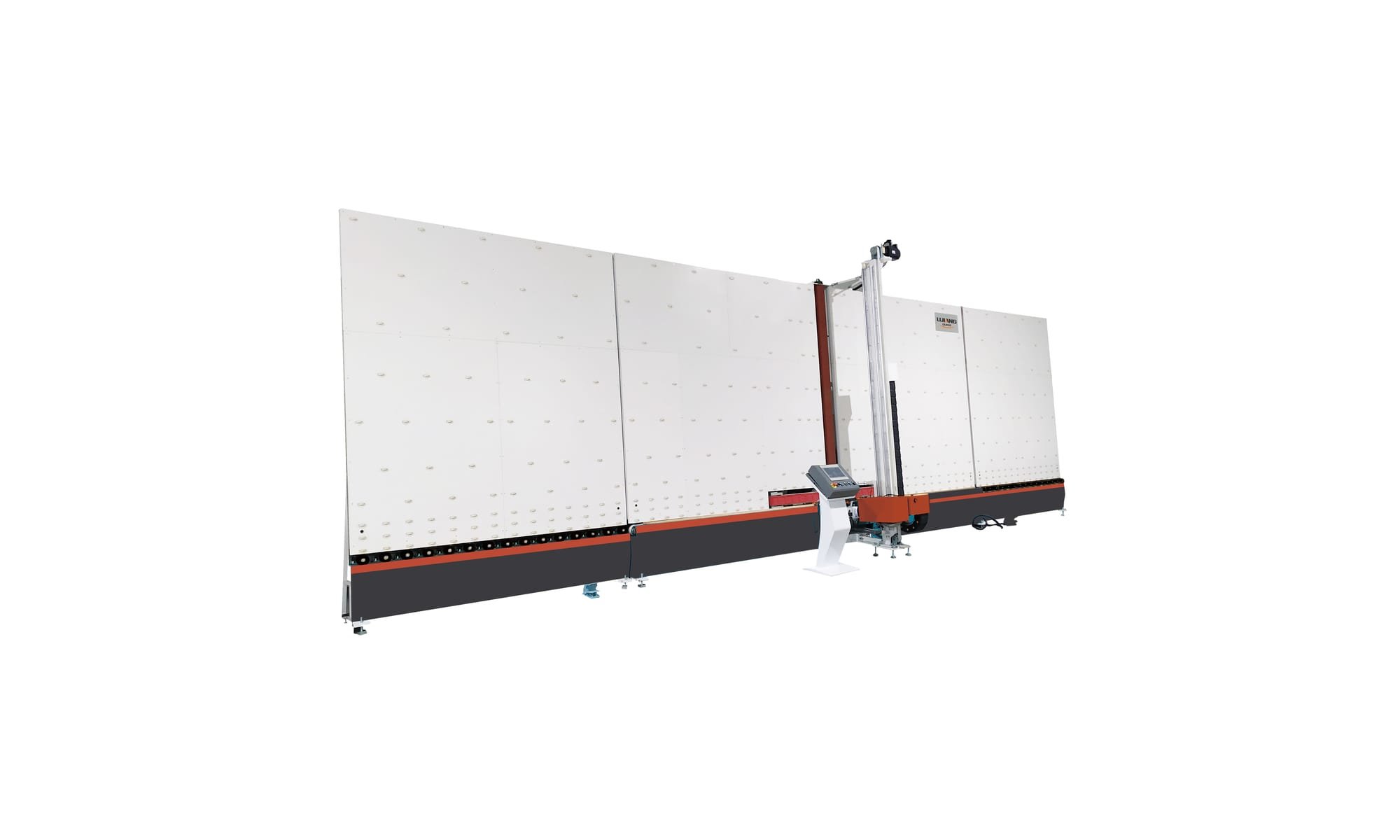
Principe de fonctionnement de base
- Six ensembles de servomoteurs, système britannique TRIO ;
- Entrée-sortie à deux directions, 4 directions sont disponibles ;
- Mesurez automatiquement la taille du verre ;
- Distinguer automatiquement le revêtement de verre Low-E ;
- La largeur de la suppression des bords de verre Low-E est réglable ;
- Adopte le système de contrôle PLC, l'interface à écran tactile pour le fonctionnement tactile ;
- Système de contrôle intelligent, pourrait reconnaître le traitement par lots.
Étapes de travail détaillées
- Suppression du verre Low-E façonné ;
- Reconnaître automatiquement le film de verre Low-E.
Paramètre technique
| Item. | Spec. |
| Voltage | 380V 50Hz 3P |
| Max. Glass Processing Size | 2500 mm*4500 mm |
| Min. Glass Processing Size | 300 mm*400 mm |
| Glass Thickness | 3-15 mm |
| Low-E Edge Deleting Width | 10-500 mm |
| Glass Conveying Speed | 0-30 m/min |
| Low-E Glass Edge Deleting Speed | 2-29 m/min |
| Grinding Wheel Width | 10/12/15 mm |
| Total Power | 15 Kw |
| Dimension(L*W*H) | 9700*2500*3400 mm |
| Weight | 2600 Kg |
Description technique
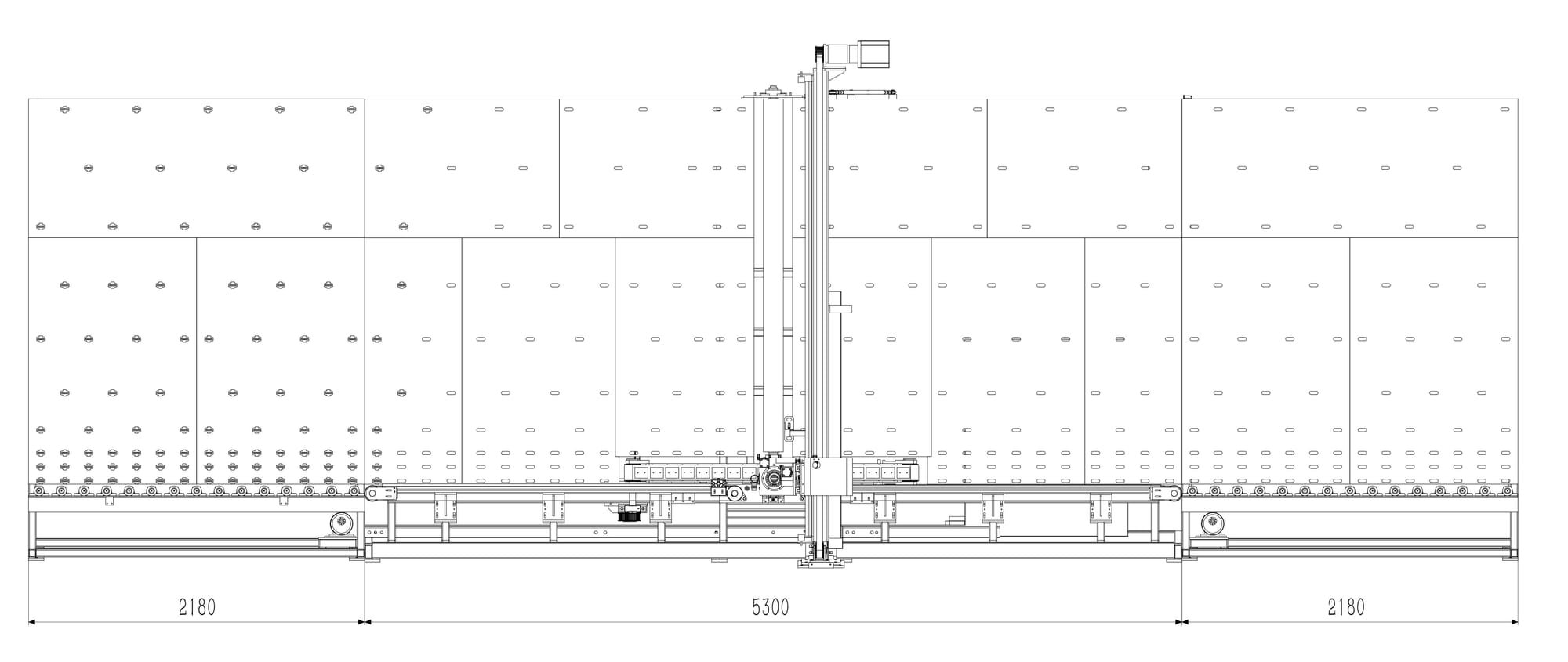
Équipement de robot de scellement de verre isolé automatique
Verre LIJIANG - Type : LJTJ2030/LJTJ2540

Principe de fonctionnement de base
- Adopte le système de servocommande Japan Yaskawa, entièrement automatique et à haute efficacité;
- Fonction de mémoire automatique, pas besoin de saisir les paramètres à plusieurs reprises ;
- Réparez automatiquement les coins en verre avec un grattoir et un rouleau ;
- La section de convoyage de l'équipement peut être divisée en quatre sections et le verre peut être pré-stocké ;
- Mesurez automatiquement la taille et la profondeur du verre, ajustez la vitesse de scellement ;
- Adoptez la courroie de distribution, le transfert en douceur et la position précise ;
- Chaque fonction automatique est à commande manuelle ;
- Pourrait recouvrir le double vitrage, le verre façonné, le verre à marches, le triple verre.
- Un ensemble de pompe de surpression contrôle deux groupes de produits d'étanchéité ;
- Fonction de décharge automatique du mastic de synchronisation ;
- Le système de mélange de mastic adopte une structure antiblocage et est facile à nettoyer.
Étapes de travail détaillées
Equipment preparation: a. Make sure the power connection of the sealing line is normal, and confirm that the required air source and glue supply system are working properly. b. Check whether all components and sensors of the sealing line are intact, and perform necessary maintenance and cleaning.
Set parameters: a. On the control interface of the sealing line, set relevant parameters, such as glass plate size, sealing speed, sealing width, sealing thickness, etc. Set parameters according to product requirements and process specifications. b. If using two-component glue, you need to set the glue ratio and mixing time.
Start the sealing robot equipment: a. Press the start button to start the sealing robot equipment. Ensure the safety of the insulating glass production line and wait for the sealing robot equipment to enter normal working conditions.
Automatic conveying of glass plates: a. Place the glass plate to be sealed on the conveyor belt or transmission mechanism to ensure that the position and positioning of the glass plate are accurate.
Automatic sealant sealing application: a. The sealing line will automatically apply sealant evenly to the edge of the glass plate or the parts that need to be sealed according to the set parameters. Ensure that the sealing robot equipment works stably and the glue is sprayed evenly.
Glass plate fixing: a. After the sealant is sprayed, the sealing line will fix another glass plate to be sealed on the glass plate that has been coated with sealant. Make sure the glass panels are aligned accurately and sealed tightly.
Sealant sealing and compression: a. The insulating glass sealing robot machine will perform a certain pressure treatment on the two glass plates to ensure a tight combination of the sealant and the glass plates. Set appropriate pressure and duration based on product requirements and equipment capabilities.
Set parameters: a. On the control interface of the sealing line, set relevant parameters, such as glass plate size, sealing speed, sealing width, sealing thickness, etc. Set parameters according to product requirements and process specifications. b. If using two-component glue, you need to set the glue ratio and mixing time.
Start the sealing robot equipment: a. Press the start button to start the sealing robot equipment. Ensure the safety of the insulating glass production line and wait for the sealing robot equipment to enter normal working conditions.
Automatic conveying of glass plates: a. Place the glass plate to be sealed on the conveyor belt or transmission mechanism to ensure that the position and positioning of the glass plate are accurate.
Automatic sealant sealing application: a. The sealing line will automatically apply sealant evenly to the edge of the glass plate or the parts that need to be sealed according to the set parameters. Ensure that the sealing robot equipment works stably and the glue is sprayed evenly.
Glass plate fixing: a. After the sealant is sprayed, the sealing line will fix another glass plate to be sealed on the glass plate that has been coated with sealant. Make sure the glass panels are aligned accurately and sealed tightly.
Sealant sealing and compression: a. The insulating glass sealing robot machine will perform a certain pressure treatment on the two glass plates to ensure a tight combination of the sealant and the glass plates. Set appropriate pressure and duration based on product requirements and equipment capabilities.
Paramètre technique
| Item. | Spec. |
| Max. Glass Size | 2000*3000 mm/2500*4000 mm/3300*7000 mm |
| Min. Glass Size | 400*300 mm |
| Glass Thickness | 12-56 mm/12-56 mm/12-80 mm |
| Working Speed | 5-40 mm |
| Air Pressure | 0.6-0.8 MPa |
| Squeeze Pressure | <35 MPa |
| Voltage | 380V 50Hz 3P |
| Power | 15 Kw/15 Kw/20 Kw |
| Overall Dimension(L*W*H) | 3700*2500*3000 mm/8700*2500*3500 mm/ 15000*2500*4300 mm |
| Weight | 4300 kg/5000 kg/7000 kg |
Description technique
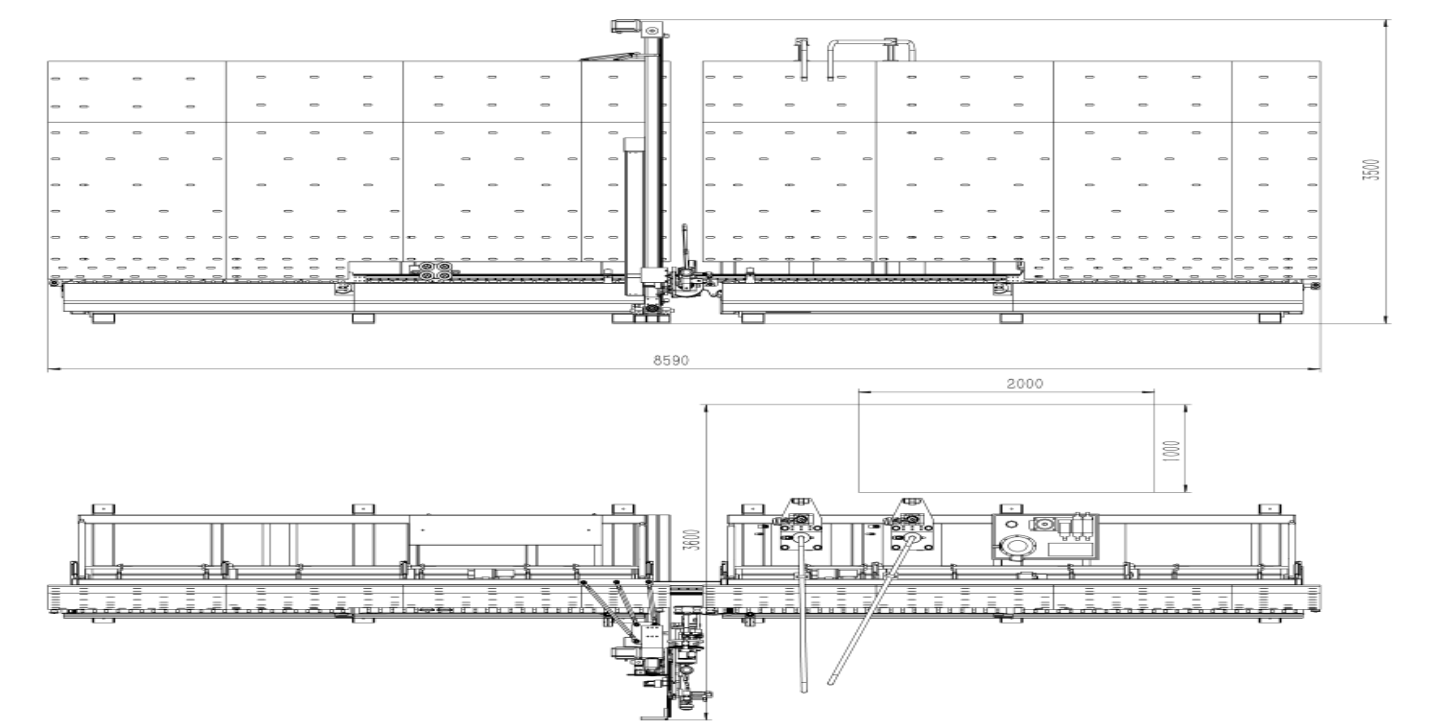 Équipement de robot de scellage de verre isolé automatique LJTJ2030/LJTJ2540 2
Équipement de robot de scellage de verre isolé automatique LJTJ2030/LJTJ2540 2 Cintreuse d'entretoise en aluminium de verre isolé automatique
Verre LIJIANG - Type : LJZW2020 / LJZW2020N
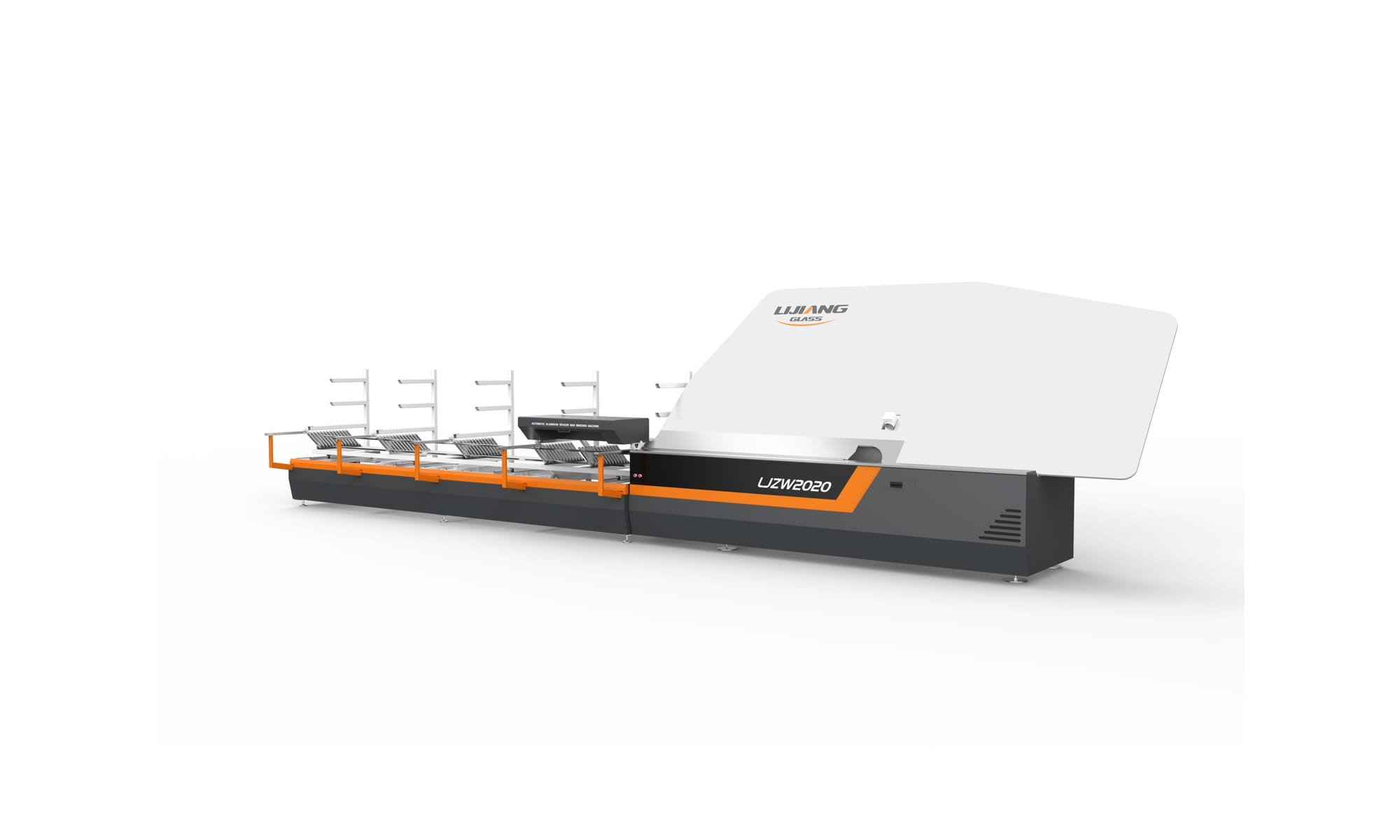
Principe de fonctionnement de base
General Performance
Optional Performance
- Adopts the servo control feeding system, the size of aluminum spacers could be adjusted with an accuracy of 0.1 mm/m;
- CNC Bending angle control system with adjustable accuracy of 0.1°;
- Sets up four groups of aluminum spacers and stainless steel spacers storage units;
- Aluminum spacer bars with multiple sizes could be selected at will;
- Automatically adjust the bending speed according to the size of the aluminum spacer or stainless steel spacer to avoid the deformation of the large spacer and ensure the high speed and continuity of the small frame;
- Automatic continuous connection of spacer, cutting spacer, avoidance of spacer joint;
- No material prompt, sleep prompt, fault prompt, work prompt, unreasonable data refuse processing and prompt support arc-shaped aluminum spacer and special shaped aluminum spacer bending;
- USB function, which could read EXCEL directly;
Optional Performance
- Could connect with ERP system;
- Could optional the function of automatic printing code, automatic printing label, bending the stainless steel spacer, bending the warm edge spacer, bending the stainless steel composite warm edge strips, bending the glass fiber warm edge strips, and bending the pure opaque steel strips.
Étapes de travail détaillées
Étapes de fonctionnement
- Allumez l'alimentation, allumez l'interrupteur de fonctionnement sur la console de commande et appuyez sur la pompe à huile pour démarrer.
- Ajustez la course. Faites attention à ajuster la course avant utilisation ; et un espace doit être défini lorsque la machine à cintrer se déplace de haut en bas vers le bas. Un réglage sans espace entraînera une certaine usure de l'équipement de la cintreuse.
- Sélection de l'encoche de la cintreuse. La base de sélection est la suivante : l’épaisseur de la plaque de verre est environ 8 fois la largeur. Par exemple, si l'épaisseur de la plaque de verre est de 5 cm, alors l'encoche doit être de 40 cm.
- Ajustez manuellement ou électriquement la butée derrière la cintreuse.
- Appuyez sur la pédale pour effectuer le pliage.
- Pendant le traitement, l'état et l'effet du traitement du verre doivent être observés à tout moment pour éviter une panne d'équipement ou des produits défectueux.
- Lorsque la machine à cintrer cesse de fonctionner, éteignez l'interrupteur de commande sur la table d'opération, puis coupez l'alimentation et nettoyez la surface de travail de la machine à cintrer pour rendre la surface propre et bien rangée pour la prochaine utilisation.
Paramètre technique
| Item. | Spec. |
| Max. Bending Size | 1800*2000 mm (in once)/ 2500*4000 mm(in twice) |
| Min. Bending Size | 150*300 mm |
| Aluminum Spacer Width | 5.5-26.5 mm |
| Spacers Racks | 4 |
| Spacer Size Error | ±0.5 mm |
| Angle Error | ±1° |
| Conveying Speed | 1250 mm/s |
| Air Pressure | ≥0.65 MPa |
| Voltage | 380 50Hz 3P |
| Total Power | 2.5 Kw |
| Dimension(L*W*H) | 10500 mm*2200 mm*2600 mm |
| Weight | 1580 kg |
Description technique
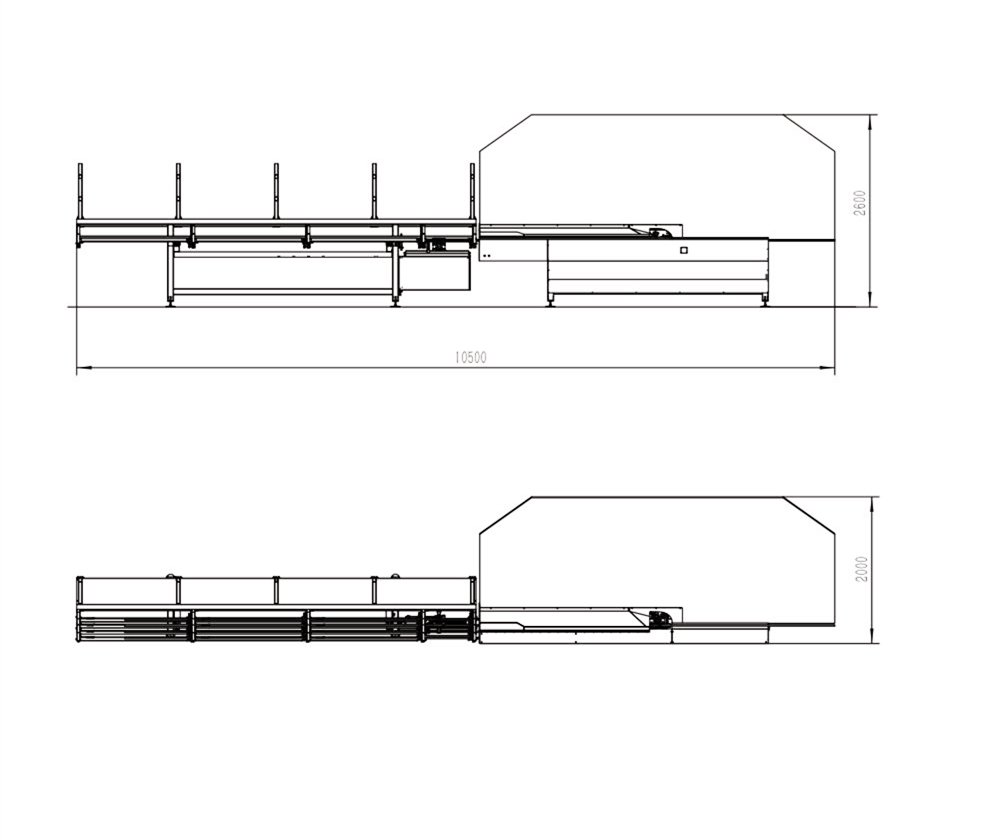 Cintreuse d'entretoise en aluminium pour verre isolant LJZW2020
Cintreuse d'entretoise en aluminium pour verre isolant LJZW2020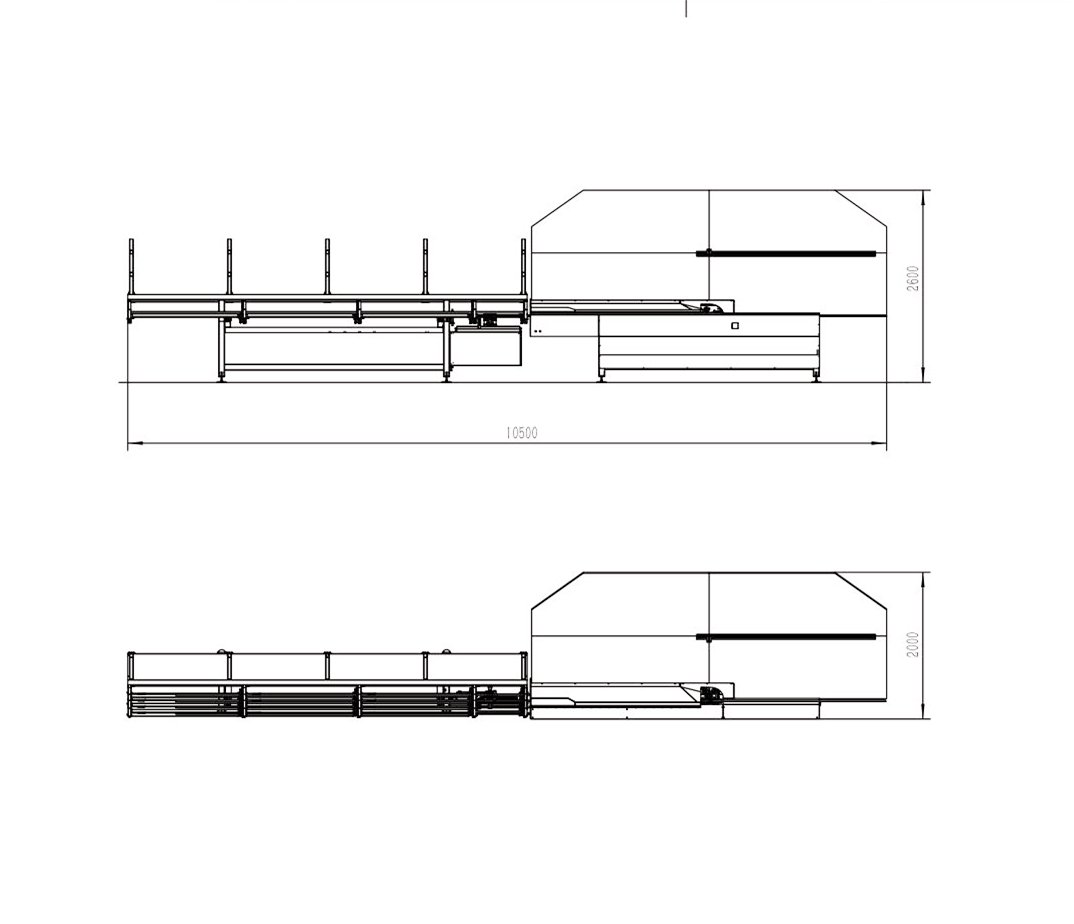 Cintreuse d'entretoise en aluminium pour verre isolant LJZW2020A
Cintreuse d'entretoise en aluminium pour verre isolant LJZW2020A Machine de revêtement d'extrudeuse butyle à grande vitesse en verre isolé
Verre LIJIANG - Type : LJTB01
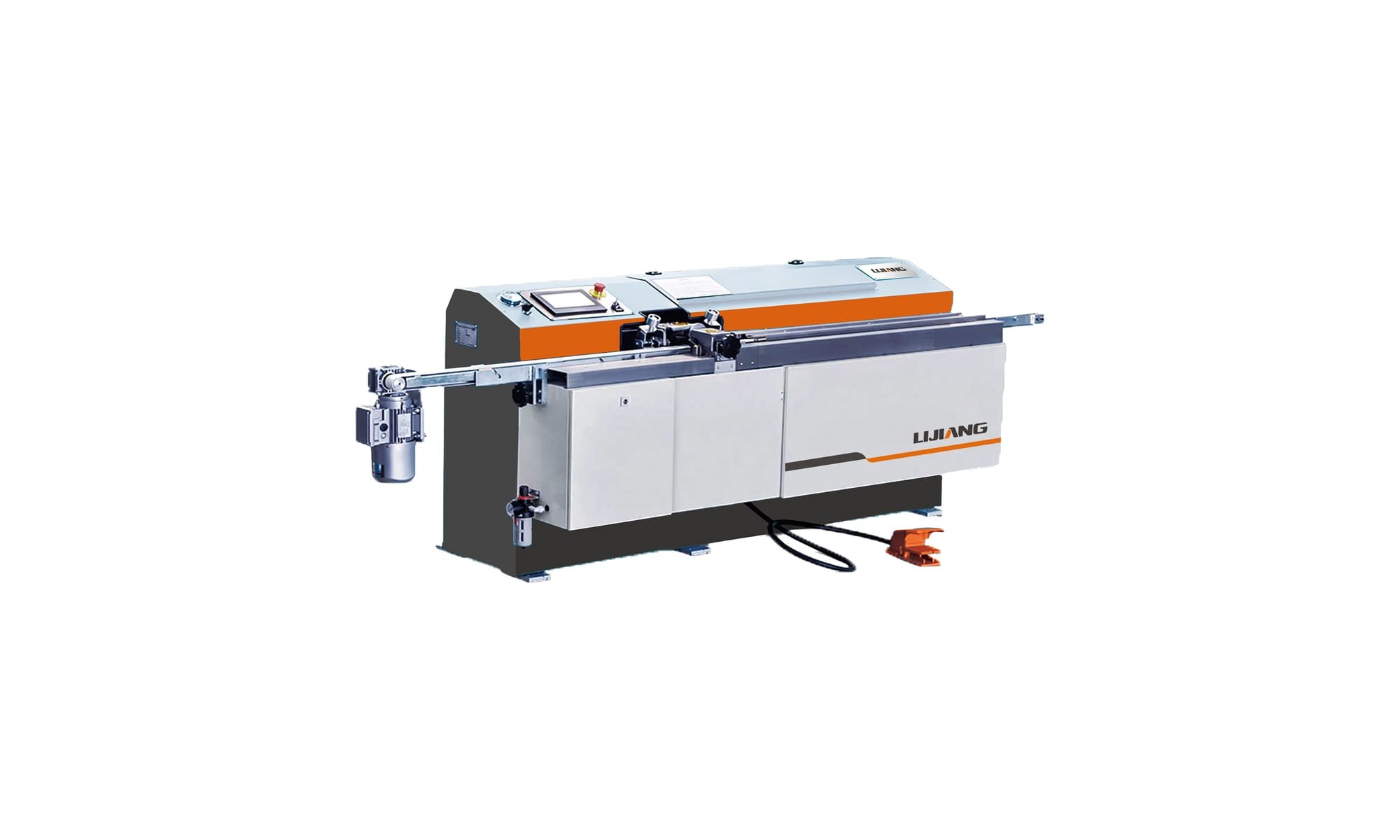
Principe de fonctionnement de base
- La vitesse d'extrusion du butyle pouvait atteindre 47 m/min ;
- En économisant du butyle par rapport à une machine ordinaire, la colle peut atteindre 7 g/m;
- Échappement manuel, opération simple ;
- Adoptez une courroie synchrone non adhésive, la poudre de talc n'est pas nécessaire pour la nettoyer;
- Les principaux accessoires sont fabriqués en marque allemande, contrôle du programme PLC, performances stables;
- Utilisant la libération verticale mobile de butyle et l'extrusion horizontale, commode et pratique ;
- Ajustez automatiquement la largeur de la tête de colle, assurez-vous que le collage double face est compatible avec le contrôle intégré de la valeur d'ouverture rapide ;
- Le réglage de la hauteur du faisceau est pratique, efficace pour résoudre le problème de la ligne d'écriture ;
- Utilisez le fonctionnement de l'écran tactile, essai simple ;
- Ajustez automatiquement la sortie de butyle en fonction du changement de vitesse ;
- Adoptez un système hydraulique de marque pour assurer une sortie de caoutchouc uniforme et complète ;
- Le cylindre buytl adopte la structure pull-up, ce qui est pratique pour changer le revêtement de l'extrudeuse en butyle.
Étapes de travail détaillées
Operation Steps
The following steps should be followed before and after each operation:
1. Start the conveyor belt
Adjust the conveyor belt to the appropriate speed, with an adjustable range of 8-30m/min.
2. Adjust the position of the rubber extrusion head
According to the width requirements of the spacer, adjust the distance between the two extrusion heads, the range is 6-16mm. When adjusting, the spacer (frame) should be centered with the small pressure wheel and the butyl extrusion nozzle, and the positions of the conveyor belt frame, butyl extrusion seat, and butyl extrusion head should be adjusted according to the height of the adhesive tape.
3. Butyl extruder temperature adjustment before work
Generally, the heating control switch is turned on about 1-2 hours before work, and the glue head temperature is set to 120-140℃ and the glue tank temperature is 110-120℃. Since the heating temperatures and process parameters specified for butyl rubber produced by various manufacturers are different, the above heating temperatures and times are for reference only.
4. Adjustment of opening and closing of the butyl extruder valve
After the heating system reaches the set temperature, do not open the hydraulic station first, but proceed as follows:
Process time setting:
According to the screen prompts, switch to the screen that needs to be adjusted, press the SET key, and the adjustable value will flash. The "←, →" keys change the position of the value; press the "↑" key to increase the value; press the "↓" key to decrease the value. After setting, press the ENT key and the data will be automatically stored, otherwise, the data will remain at the original value.
A. Adjust the time of the right pressing wheel: Make the front end of the spacer frame (strip) on the conveyor belt and the center of the extrusion head, so that the right pressing wheel presses on the aluminum spacer frame (strip). Before the end of the spacer frame (strip) passes through the right pressure wheel, the right pressure wheel can be lifted smoothly, which is very important for the bent spacer frame.
B. Adjust the time of the left pressing wheel: make the front end of the spacer frame (strip) on the conveyor belt, and make the left pressing wheel press on the aluminum spacer frame (strip). Before the end of the spacer frame (strip) passes through the left pressure wheel, the left pressure wheel can be lifted smoothly, which is very important for the bent spacer frame.
C. Adjust the butyl extruder spraying time: When the front end of the spacer frame (strip) is on the conveyor belt and is in the center of the butyl extrusion head, the butyl valve cylinder moves and the buytl valve opens; when the end of the spacer frame (frame) passes the butyl nozzle, close the butyl valve, no excess butyl leaks out.
5. Turn on the hydraulic station:
Before opening the hydraulic station, check the relative positional alignment of the butyl extrusion piston and the center of the butyl cylinder to ensure that the butyl extrusion piston can be correctly pressed into the butyl cylinder. Otherwise, damage to the butyl cylinder and the oil cylinder will occur. When the pumping station starts, the cylinder lift switch should be adjusted to the middle position (zero position). At this time, the pressure regulating valve should be in the open state. After the pumping station starts, gradually adjust the pressure regulating valve to increase the system pressure to the working pressure, but The working pressure shall not exceed 18MPa. When the room temperature is too high in summer and the hydraulic station works for a long time, the temperature will rise too high and the hydraulic oil will become thinner and lose working pressure. At this time, the hydraulic station should be suspended and restarted after the oil temperature drops.
6. Butyl extruder injection
A. Adjust the cylinder lift switch to the middle position and start the hydraulic station. When the hydraulic station starts and stabilizes, turn the cylinder lift switch to the "up" position to lift the cylinder piston away from the rubber tank and reach the highest position.
Note: If there is still butyl left in the glue tank and the piston of the butyl tank is not lifted after operation, the piston of the butyl tank should be heated to the specified temperature before lifting, otherwise the equipment will be damaged.
B. Start operating the swing mechanism
First, lift the piston of the butyl tank to leave the butyl tank, push the cylinder by hand to leave the cylinder mouth, and then insert the butyl ingot. After completion, reset the cylinder piston.
7. Air pressure adjustment:
The pressure of the doublet shall not be less than 0.6MPa. The air pressure of the swing motor that drives the small pressure wheel is individually adjusted to 0.15-0.4MPa by the pressure regulating valve.
The following steps should be followed before and after each operation:
1. Start the conveyor belt
Adjust the conveyor belt to the appropriate speed, with an adjustable range of 8-30m/min.
2. Adjust the position of the rubber extrusion head
According to the width requirements of the spacer, adjust the distance between the two extrusion heads, the range is 6-16mm. When adjusting, the spacer (frame) should be centered with the small pressure wheel and the butyl extrusion nozzle, and the positions of the conveyor belt frame, butyl extrusion seat, and butyl extrusion head should be adjusted according to the height of the adhesive tape.
3. Butyl extruder temperature adjustment before work
Generally, the heating control switch is turned on about 1-2 hours before work, and the glue head temperature is set to 120-140℃ and the glue tank temperature is 110-120℃. Since the heating temperatures and process parameters specified for butyl rubber produced by various manufacturers are different, the above heating temperatures and times are for reference only.
4. Adjustment of opening and closing of the butyl extruder valve
After the heating system reaches the set temperature, do not open the hydraulic station first, but proceed as follows:
Process time setting:
According to the screen prompts, switch to the screen that needs to be adjusted, press the SET key, and the adjustable value will flash. The "←, →" keys change the position of the value; press the "↑" key to increase the value; press the "↓" key to decrease the value. After setting, press the ENT key and the data will be automatically stored, otherwise, the data will remain at the original value.
A. Adjust the time of the right pressing wheel: Make the front end of the spacer frame (strip) on the conveyor belt and the center of the extrusion head, so that the right pressing wheel presses on the aluminum spacer frame (strip). Before the end of the spacer frame (strip) passes through the right pressure wheel, the right pressure wheel can be lifted smoothly, which is very important for the bent spacer frame.
B. Adjust the time of the left pressing wheel: make the front end of the spacer frame (strip) on the conveyor belt, and make the left pressing wheel press on the aluminum spacer frame (strip). Before the end of the spacer frame (strip) passes through the left pressure wheel, the left pressure wheel can be lifted smoothly, which is very important for the bent spacer frame.
C. Adjust the butyl extruder spraying time: When the front end of the spacer frame (strip) is on the conveyor belt and is in the center of the butyl extrusion head, the butyl valve cylinder moves and the buytl valve opens; when the end of the spacer frame (frame) passes the butyl nozzle, close the butyl valve, no excess butyl leaks out.
5. Turn on the hydraulic station:
Before opening the hydraulic station, check the relative positional alignment of the butyl extrusion piston and the center of the butyl cylinder to ensure that the butyl extrusion piston can be correctly pressed into the butyl cylinder. Otherwise, damage to the butyl cylinder and the oil cylinder will occur. When the pumping station starts, the cylinder lift switch should be adjusted to the middle position (zero position). At this time, the pressure regulating valve should be in the open state. After the pumping station starts, gradually adjust the pressure regulating valve to increase the system pressure to the working pressure, but The working pressure shall not exceed 18MPa. When the room temperature is too high in summer and the hydraulic station works for a long time, the temperature will rise too high and the hydraulic oil will become thinner and lose working pressure. At this time, the hydraulic station should be suspended and restarted after the oil temperature drops.
6. Butyl extruder injection
A. Adjust the cylinder lift switch to the middle position and start the hydraulic station. When the hydraulic station starts and stabilizes, turn the cylinder lift switch to the "up" position to lift the cylinder piston away from the rubber tank and reach the highest position.
Note: If there is still butyl left in the glue tank and the piston of the butyl tank is not lifted after operation, the piston of the butyl tank should be heated to the specified temperature before lifting, otherwise the equipment will be damaged.
B. Start operating the swing mechanism
First, lift the piston of the butyl tank to leave the butyl tank, push the cylinder by hand to leave the cylinder mouth, and then insert the butyl ingot. After completion, reset the cylinder piston.
7. Air pressure adjustment:
The pressure of the doublet shall not be less than 0.6MPa. The air pressure of the swing motor that drives the small pressure wheel is individually adjusted to 0.15-0.4MPa by the pressure regulating valve.
Paramètre technique
| Item. | Spec. |
| Voltage | 380V 50Hz 3P |
| Power | 5.7 Kw |
| Butyl Extrusion Pressure | 10·25 MPa |
| Temperature | 110~140 ℃ |
| Glue Thickness | 0.3~0.5 mm |
| Glue Width | 3.5 mm |
| Aluminum Spacer Width | 5.5~26.5 mm |
| Speed | 0~47 m/min |
| Diameter of Butyl Cylinder | 200 mm |
| Air Supply | Flow 0.4 m³/min |
| Air Pressure | ≥ 0.6 MPa |
| Dimension(L*W*H) | 2800*700*900 mm |
Description technique
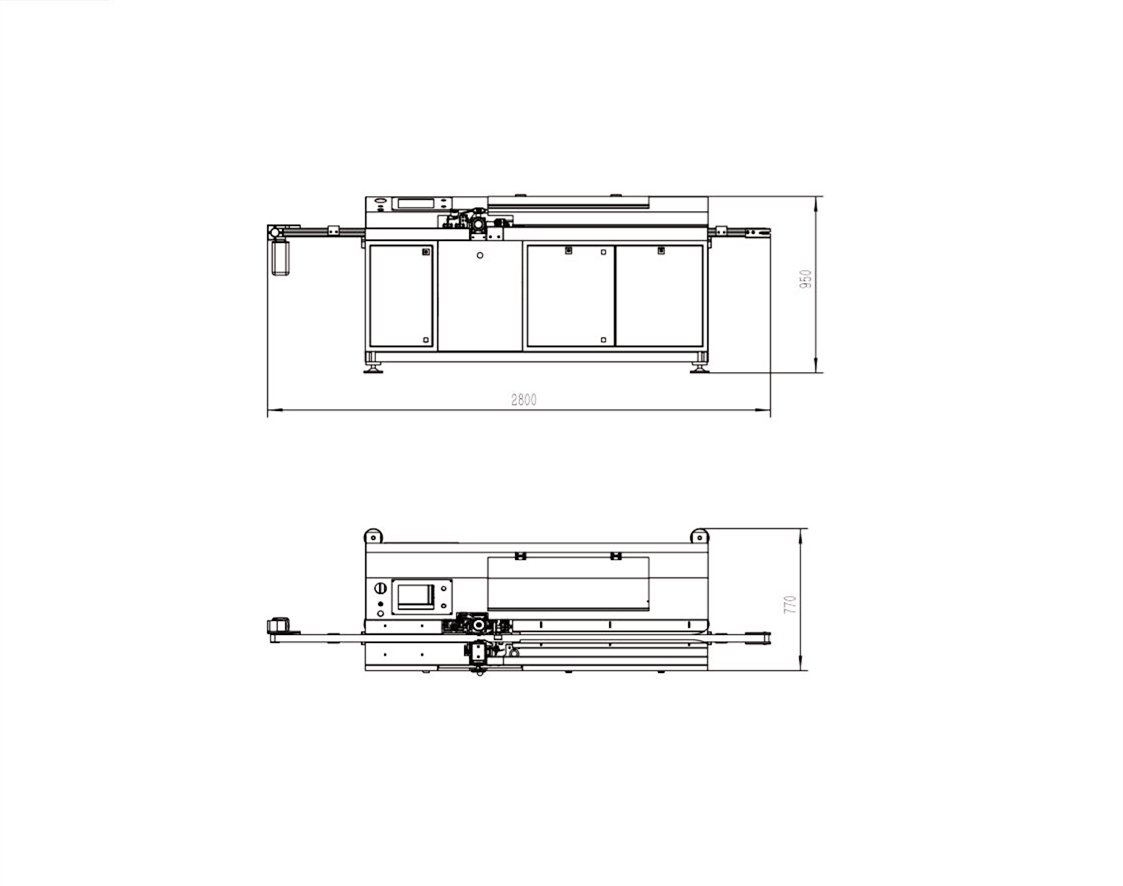 Machine de revêtement d'extrudeuse de butyle de verre isolant LJTB01
Machine de revêtement d'extrudeuse de butyle de verre isolant LJTB01 Machine de remplissage déshydratante en verre isolée automatique
Verre LIJIANG - Type : LJGZ2020D / LJGZ2020X / LJGZ2020S
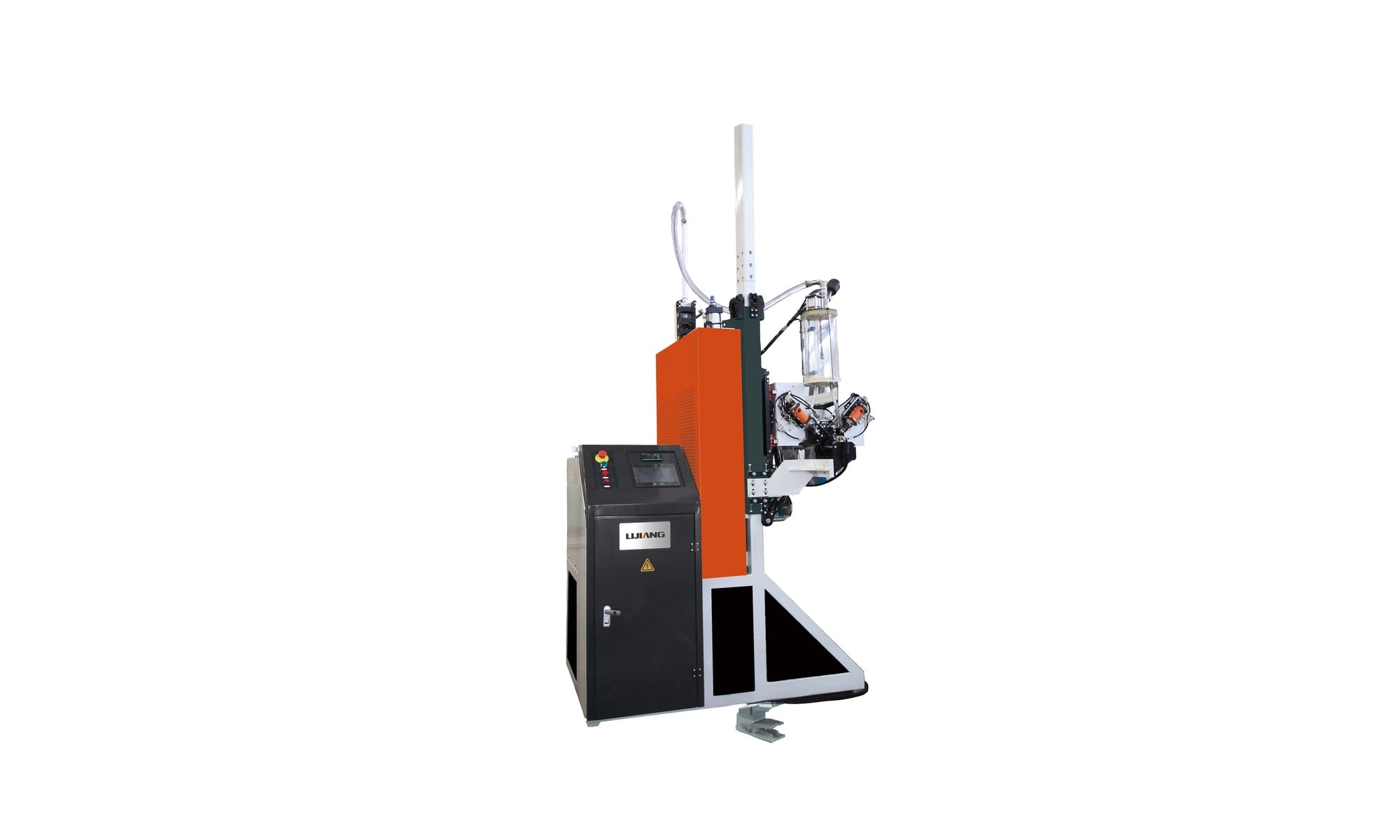
Principe de fonctionnement de base
- Adopte le système de contrôle de PLC de Siemens de l'Allemagne, exécution stable ;
- Percer, remplir et sceller automatiquement;
- La taille de machine a pu être ajustée selon la taille de l'entretoise en aluminium ou de l'entretoise d'acier inoxydable ;
- Chargement et remplissage automatiques du tamis moléculaire ;
- Dispositif d'alimentation avancé conçu selon le principe du flux de gaz ;
- Adopte le traitement de pulvérisation de plastique industriel de tous les cadres en aluminium ;
- Les pièces de base adoptent la célèbre marque importée.
Étapes de travail détaillées
Machine de remplissage déshydratante pour verre isolé LJGZ2020D
Machine de remplissage déshydratante pour verre isolé LJGZ2020X
Machine de remplissage déshydratante pour verre isolé LJGZ2020S
- En utilisant un grand baril en plastique, économisez du temps d'alimentation et améliorez l'efficacité ;
- Dispositif de protection pour tête de machine
- Entretoise en aluminium en forme de remplissage ou entretoise en acier inoxydable
- Pourrait remplir le tamis moléculaire à grandes particules dont les tailles sont de 1,0 à 1,5 mm
Machine de remplissage déshydratante pour verre isolé LJGZ2020X
- Avec le dispositif de levage du rail de guidage
- La tête est stable pendant le travail
- Avec grande fonction auxiliaire d'entretoise
Machine de remplissage déshydratante pour verre isolé LJGZ2020S
- Deux stations-service pourraient fonctionner en même temps pour améliorer l'efficacité du travail ;
- Deux stations pourraient réaliser différentes combinaisons de remplissage ordinaire, de remplissage de forme spéciale et de remplissage à grosses particules. (optionnel)
Paramètre technique
| Article. | Spéc. |
| Max. Taille du cadre | 2000 millimètres*2000 millimètres |
| Min. Taille du cadre | 300mm*250mm |
| Spécification de l'aluminium | 5,5 ~ 26,5 millimètres |
| Pression de l'air | ≥ 0,65 MPa |
| Tension | CA 220V 50Hz |
| Du pouvoir | 1Kw |
| Diamètre de tamis moléculaire nécessaire | 0,5 ~ 0,9 mm (pourrait être personnalisé 1,0 ~ 1,5 mm) |
| Dimensions (L*W*H) | 1400*1200*3600 millimètres |
| Lester | 3000 kilogrammes |
Description technique
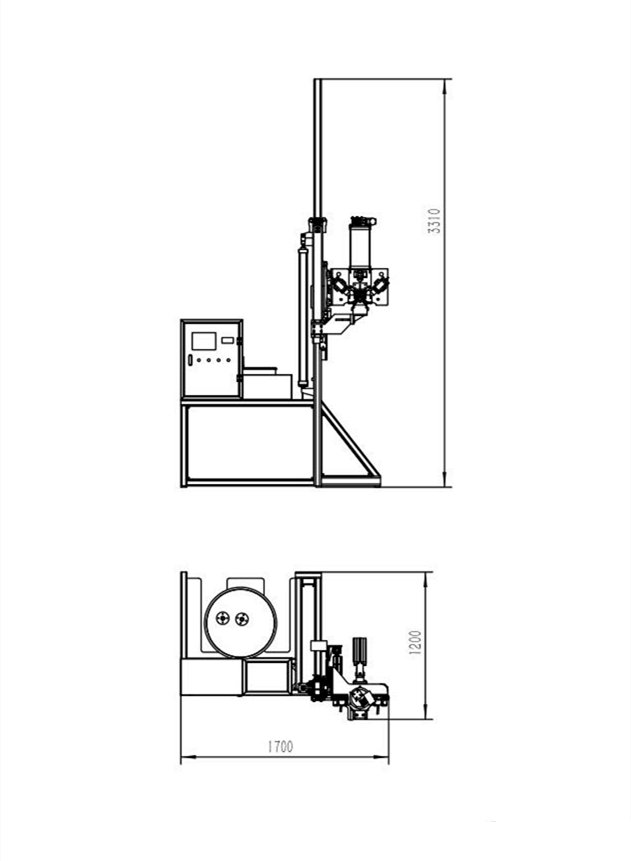 Machine de remplissage déshydratante pour verre isolant LJGZ2020A
Machine de remplissage déshydratante pour verre isolant LJGZ2020A 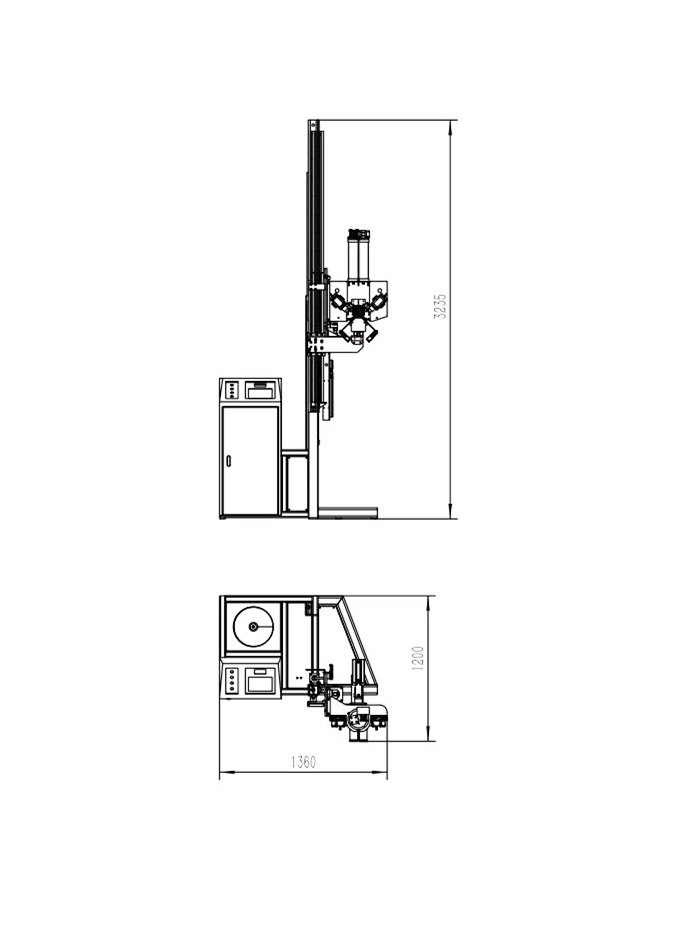 Machine de remplissage déshydratante pour verre isolant LJGZ2020X
Machine de remplissage déshydratante pour verre isolant LJGZ2020X 